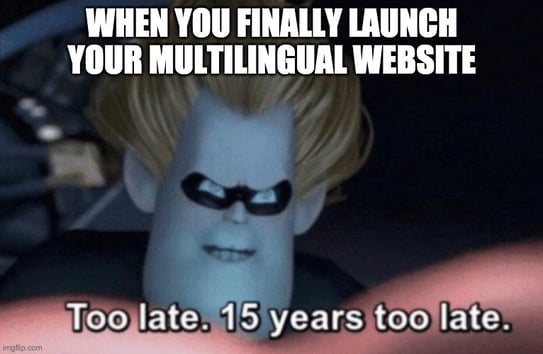.png?width=740&name=multilingual%20website%20that%20makes%20money%20(1).png) What's the next step after you've identified the markets with the biggest potential for your business growth?
What's the next step after you've identified the markets with the biggest potential for your business growth?
It's creating your multilingual website.
Our numerous international customers share a common goal: To sell more in foreign countries. Adding new languages to your website directly leads to increased website traffic from the targeted countries and in consequence, quality leads from those countries.
Based on our experience, we gathered a list of 11 questions to ask before you start your website translation. This should help you learn how to translate your website, speed up the website localization process, launch your multilingual website, meet your time-to-market and increase your ROI.
You need a well thought out plan for your website translation.
First, choose the languages for translation. When choosing the languages you need to think about your localization strategy. You need to understand why your company is focusing on website translation into certain languages. It’s really about prioritizing markets, unless you plan to translate your content into multiple languages at once.
How do you figure out where to start?
You have to balance between how big the market is versus how sensitive your audience is to having content in their native language. Some languages will open many more doors than others.
Related content: 15 Languages for Translation That You Should Know About
Our customers have also chosen their languages based on the countries where they were planning to have M&As. If you’re planning an M&A in Spain, Spanish should become a priority language for you.

Say you want to have a multilingual website at some point, but not now. For now you’re just redesigning your website and thinking about adding multiple languages sometime in the future, when you’re ready.
Well, that might not be the ideal solution. There is no better time to think about adding languages to your website than when you are redesigning it or building it from scratch.
Thinking ahead has helped numerous companies avoid redoing their websites. It’s also useful to remember that at some point in the future you may need to change translation companies.
If you have translated your website in the system owned by your translation company, you may have trouble with changing translation company, as this could mean completely redoing your website. Be careful what CMS you choose for your website so as not to end up being practically married to your CMS providers.
Another big topic to consider is international SEO for your website. The sooner you think about it, the less hassle it is going to cause you later.
Related content: A Quick Introduction to SEO Localization

We have been asked many times by our clients about timelines because they did not want to have to change the roll out date for their product, or they wanted to make sure their newsletter was going to be sent to all countries at the same time.
Depending on a number of factors like the complexity of the text, the amount of content to be localized, as well as what the customer really needs, the turnaround time for website translation may vary.
If you have established your timeline for publications, the translation company will be able to suggest either dividing the content between a couple of teams, or allowing enough time to work with just one team of linguists.
Related content: How to Reduce Turnaround Time for Content Translation
There can be a number of teams working on one website localization if the deadline is short. In an ideal world, translation companies dedicate one team to one translation project to make sure they get to know you and focus specifically on your account.
If it is necessary to divide the project between more than one team, don’t worry. A translation agency worth their salt will have a dedicated project manager that will personally see to it that all the teams working on your content have all the reference materials, know your instructions, and adhere to all the guidelines to ensure consistency throughout the content.
Related content: 7 Things a Translation Project Manager Handles for You So You Don't Have to
.png?width=536&name=insourcing%20vs.%20outsourcing%20translation%20(1).png)
A lot of companies see their in-country sales reps, who have product training and experience in speaking to the audience of a given country, as potential translators of their website.
The sales and marketing teams certainly have product knowledge and understand their international clients’ needs.
Related content: Translation Agency vs. In-house Marketing Team: Who Should Translate Your Content?
Do your sales reps, marketing people or local product distributors have the skills needed to translate technical documentation for the audience they feel so confident talking to?
They are probably better off doing their job and already have their hands full anyway. Professional translators are prepared to convey your message in the right way.
Though you might argue that they have little knowledge of your product or service, as they’ve never worked on it before, they have worked for other companies in your field and know your industry inside out. It’s very likely that they have already worked on your competitors’ content, simply because translators tend to specialize in narrow fields.
Due to the specific competences needed for your industry, translation agencies normally work exclusively with translators who have a certain knowledge and experience in the required industry. They are experienced in translating industry technical phrases, to adequate local expressions.
And making sure that such linguists work on your website is not something that you need to worry about. When you trust your content to a translation company, it’s their vendor and project management’s job to find, vet, and hire the right linguists for the project.
Related content: Do I Really Have to Work With a Translation Vendor Manager?
Translation agencies hire expert linguists who are based in the country and make sure they are native speakers. There is a common misconception that someone who speaks a language can translate or review content in that particular language.
They certainly may try, but that will most likely be a surplus task they have to handle, and the amount of time they’d have to spend on it is double the time experts from a translation agency would take.
Related content: Translation Agencies vs. Local Distributors: Compare Your Options
Not to mention the quality of such translation. Don’t fall into the trap of thinking that just anyone can translate content just because they speak the language. If that were the case, the language industry would have never come to exist.
.png?width=539&name=managing%20translation%20process%20visualization%20(1).png)
Over the last 15 years, we have worked with a great number of marketing and product directors who have one thing in common: They all manage a lot of external partners, e.g., creative agencies, advertising, and graphic designers. This also means managing their work through different tools. Additionally, different teams using various tools means different tools needed on our end.
Having one contact person, e.g., your digital marketing manager, seems to be a great idea. But you should expect the translation team to want to consult other members of your team as well, especially the authors of the content, to make sure their specific expectations are met.
.png?width=522&name=choosing%20a%20point%20of%20contact%20for%20a%20translation%20project%20(1).png)
For website translation, the development team has to be onboard from the very beginning, no doubt.
To start the discussion, the client usually wants to have an idea of how much it will cost. A lot of marcomm directors assume that once the translation provider has a link to their website, they can suggest a price and estimate how much time will be needed to translate their website.
There are some calculators that will count the number of words on a given website, but their accuracy is not yet reliable.
Related content: How Much Does Website Translation Cost?
The best way to make sure you really know how much you will pay (and save) when you translate your website is to have your translation company analyze the content in the CAT (Computer-Assisted Translation) tool.
That means that the translation company will ask you for the actual files to have them checked in a CAT tool.
It will calculate the number of words (total number in the files) against the number of weighted words (the actual words for translation). This is because there will surely be expressions or sentences that will occur repeatedly throughout the content. And there’s no need for you to pay for their translation again. Once translated, always translated. You pay once.
This way you get a clear picture of how much you will really spend on your website localization.
Related content: How to Really Save on Translation and Localization
.png?width=524&name=preparing%20documentation%20for%20translation%20project%20(1).png)
It’s always a good idea to have a style guide explaining your tone and how you want to approach your customers. To make sure nothing gets lost, it might be a good idea to have a general company style guide with general instructions for the language teams to follow.
Usually, the marketing team will have general guidelines for writing articles, etc. Get the marketing team involved and provide as much context as possible. In the translation world, context is king.
Related content: 15 Myths About Style Guides and Glossaries for Translation
Share what you already have and work with the translation agency to make sure all the bases are covered. Guidelines or glossaries can be developed by the translation team or by the translation team in cooperation with your content writers.
There certainly needs to be time assigned for making sure everyone is on the same page and knows what their role is in the localization process.
Preparing files for translation is a very tiresome task that can easily be avoided. All you need to do is integrate your system with the translation software to allow the translation team to work directly on your website backend.

The hassle of exchanging files and tracking them to make sure the final version is ready to use can be a nightmare. Luckily, translation technology is here to make sure no one has to face this challenge anymore.
Related content: A Lack of Translation Integration With Your System: Trouble Alert
-1.png?width=522&name=overspending%20on%20translation%20(1)-1.png)
Prepare for translation.
The time spent on the thoughtful preparation of your content is going to result in significant savings. Making sure your team members are available to share their expectations and goals with translation project managers and linguists will allow you to save time and money in the long run.
Related content: 7 Tips to Avoid Wasting Your Translation Budget
While working with customers with big product portfolios, we have learned that even though each product is unique, the product pages have repetitive portions of content.
Once we start the translation of product data sheets, product pages, maintenance manuals, and marketing materials, it usually turns out that a lot of the translations can be reused. The more you translate the cheaper it gets thanks to the Translation Memory storing previously translated texts
Related content: 5 Ways That Translation Companies Cause You to Overspend
.png?width=533&name=allocating%20translation%20budget%20(1).png)
What will work better for you: Translating all the webpages into fewer languages or translating just the main pages into a greater number of languages? This is an important and quite frequently asked question that needs to be addressed.
To be able to answer this question it is best to put yourself in the website user’s shoes.
Does it make sense to give them a teaser and invite them to view the website in their native language, and then instead of offering product and service pages in their language, disappoint them with the lack thereof?
Related content: 15 Simple Ways to Kill Your Multilingual Website
Make sure to remember that when you plan your website localization, starting off with a large number of languages while limiting the amount of content that you will translate may not be a good idea. It’s sometimes better to translate into one or two languages in order to deliver a truly multilingual website, and not just one page.
When you promise your clients a website in their language, make sure you deliver.
.png?width=600&name=Google%20Translate%20idea%20(1).png)
You want to translate your website, but you don’t have sufficient budget to do so. So, Google Translate may seem like a good, cheap option. It’s a trap. Don’t fall into it.
Google translate can be very useful for your audience to understand your website but since machine translation, however developed it may be, still needs human intervention, you will risk damaging your company’s reputation if your website contains poorly translated content.
Related content: What Happens When You Experiment with Machine Translation
.png?width=556&name=things%20to%20remember%20when%20starting%20website%20localization%20(1).png)
In order to create a perfect multilingual website without any delays, added costs and quality issues, make sure to remember the following things:
Find your perfect website localization partner, ask questions, answer their queries, deliver the content together with any reference material, and trust them. They know how to make sure your website puts you ahead of your competition in the global market.
Recommended articles:
10 Best Practices in Website Localization
50+ Translation Integrations That You Should Know About
A Guide to Measuring Website Localization ROI
+1 857 777 5741 ext. 203 (business inquiries)
+1 857 777 5741 ext. 205 (career inquiries)
Trylinskiego 16, 10-683
Olsztyn, Poland
Copyright ATL 2025. All Rights Reserved.